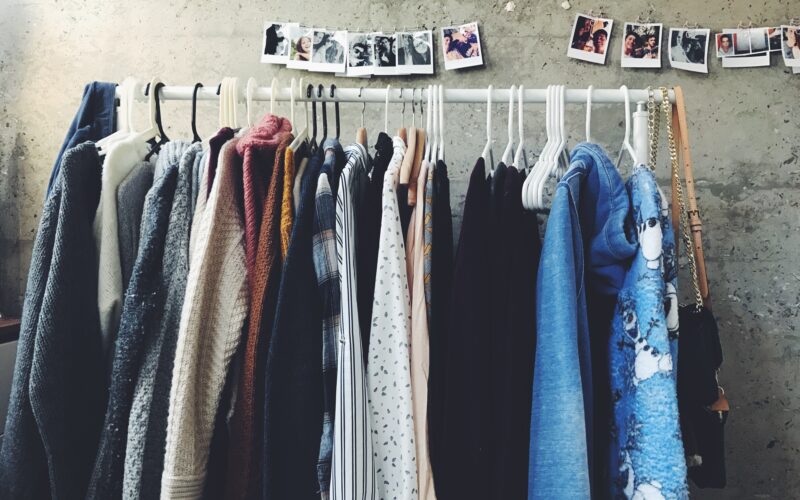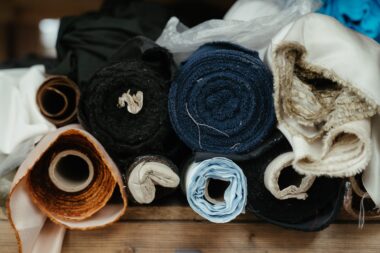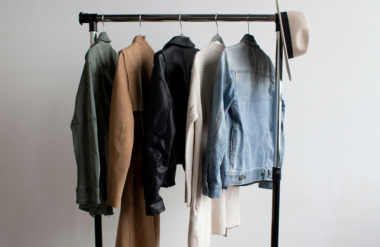I love to thrift. I’ve always loved thrifting and when I’m decluttering I either give my things to people I know, or I donate to a charity shop, or thrift store/shop, as they’re called on this side of the pond. The thought of just chucking clothes in the bin to end up in a landfill doesn’t sit right, and considering we have an abundance of places we can donate to, it probably doesn’t sit right with a bunch of other people either. But, I’ve heard some murmurs on the internet that all this good that we think we’re doing by donating isn’t actually that good after all. I’ve heard a chunk of our donated items end up in landfills or shipped abroad. So it got me thinking, what actually happens to donated clothes?
What happens once you donate?
According to a 2006 ABC report, in the United States, only 10 percent of clothing donations are kept and sold in thrift stores locally. What happens to donated clothes after that is pretty depressing. The remaining 90 percent are sold to textile recycling companies. The majority of textiles (about 70 percent) are recycled into cleaning cloths and other industrial items. But the remaining 20-30 percent are shipped off to be sold in Africa and other developing nations. Here in Canada, according to a 2018 CBC report, only about half of what gets donated ends up in a thrift shop, with about half of that actually selling. Value Village only sells about a quarter of it’s donations and the Salvation Army only keeps clothing on it’s racks for four weeks before switching it out.
Where are clothes sent?
In 2017, Canada exported $173 million of used clothing globally. The three largest importers were Kenya ($20 million), Ghana ($14 million) and India ($12 million). According to Kate Bahen of Charity Intelligence, exporting such large volumes of used clothing to developing countries ends up having a negative impact on those countries by suppressing their textile industries and dumping our waste into their landfills. In 2016, the East African Community (EAC) proposed an import ban on used clothing. Imported used clothing sells for less than locally produced clothing, eroding local industry. The goal of the ban was to reduce foreign competition, encourage local textile production and help rejuvenate a once thriving industry.
In addition to damaging local industry, there’s also the matter of the end of life of the garment. Whether clothes are resold initially or not, they eventually end up in a landfill and it’s not a landfill in Canada. Current textile recycling methods turn less than 1% of non-reusable materials back into new textiles. We haven’t developed a mass market, sustainable end-to-end model for clothing anywhere in the world yet let alone expecting a developing country to have access to the technology to do it. So at the end of the day, we’re sending our trash abroad.
What can we do instead?
The average Canadian gets rid of 37 kilograms of textiles per year with 85% of wearable textiles and 99% of non-wearable ones, such as shoes and towels ending up in a landfill. Is this a case to not donate just because of what happens to donated clothes? I don’t think so. Is this a case for people buying less stuff, reusing what you can and recycling if possible? Of course. The average Canadian now buys 72 textiles items a year, a 60 percent increase from 20 years ago, but keeps them for half the time.
But are we solely to blame here for what happens to donated clothes? Absolutely not. In my opinion, every large manufacturer and seller of pretty much anything should have the responsibility to ensure their product has a plan for end of life. Just selling it and leaving it at that shouldn’t be ok. Knowing that the end of life for a product is a landfill shouldn’t be the accepted practice.
Some innovative companies have started looking at full life cycles and creating circular systems, as opposed to the vertical supply chain of today. UK company, Worn Again Technologies aims to capture materials from non-reusable products (textiles and PET bottles) at the end of their life and convert them back into raw materials to form a circular system. Worn Again worked with McDonalds in the UK before the 2012 Olympics to create a closed loop system for their employee uniforms. A 100% recycled uniform was designed for their 85,000 restaurant staff.
Seattle-based Evrnu, another company invested in the circular textile economy, regenerates fibres from discarded clothing to create new textiles. In 2019, Evmu partnered with Stella McCartney and Adidas to create a limited run of the adidas by Stella McCartney Infinite Hoodie. The hoodie was the first item to be “made to be remade” composed of 60% NuCycl™ and 40% organic cotton that was diverted from landfills and will be returned to the NuCycl system at the end of life.
But with circular textile technology still in its infancy and still being too cost prohibitive for the mass market, is there much a single individual can do right now? We live in a capitalist, consumerism-focused, disposable society, so I’ll admit it’s not looking great and probably isn’t going to be easy.
- Start small, try not to buy disposable things.
- If you’re done with something, give it to a friend or donate it rather than throwing it out.
- If you’re buying something, try to buy second-hand.
- If you want to, or need to buy something new, and are in a position to, try and buy quality items that will last you a long time or are repairable if they break.
- Buying from companies that are focusing on sustainable, circular methods of production can also be helpful. Proving a market for this will help investment in new technology and a reduction in the cost to customers over time.
- And finally, try not to let the weight of the fact that we’ve destroyed the planet and screwed the people get you down too much. Note to reader: if you know how to do that please give me tips. Struggling.
This article was first published on January 10, 2021 on Destinationtbc.com, titled “Where do the clothes we donate go?“
Sustayn is designed to present the most useful recommendations for environmentally friendly approaches and items. We update links when possible, but note that links can be broken and subject to change.









192 comments
This is one awesome blog article.Much thanks again. Want more.
I was suggested this blog by my cousin. I am not sure whether this post iswritten by him as no one else know such detailed about my difficulty.You are wonderful! Thanks!
A motivating discussion is worth comment. There’s no doubt that that you ought to publish more on this issue, it may not be a taboo matter but typically people do not talk about such subjects. To the next! Cheers!!
Hi, this weekend is good in support of me,because this occasion i am reading this great informative paragraph here at my residence.
Really informative blog article.Really looking forward to read more. Really Great.
I cannot thank you enough for the post.Really looking forward to read more.
Say, you got a nice post.Thanks Again.
I really liked your blog post.Really thank you! Fantastic.
Thank you for your post.Much thanks again. Keep writing.
To start obtaining well timed alerts, as shown underneath click the Inexperienced “lock” icon beside the dealwith barFree Fire Account Free 2021 Garena Accounts AndPasswordFree Fire Account Free
Is anyone able to recommend good Stonemasons and Drystone Wallers B2B Marketing List? Thank you 😀
I am always browsing online for ideas that can help me. Thankyou!Visit my blog :: forum.adm-tolka.ru
You could definitely see your skills in the work you write. The arena hopes for more passionate writers like you who are not afraid to mention how they believe. Always follow your heart.
Really quite a lot of good tips!essay writer jobs essay how to write executive resume writing services
Really all kinds of beneficial info! hemp oil vs cbd oil
I am really impressed with your writing skills and also with the layout on your blog.Is this a paid theme or did you customizeit yourself? Anyway keep up the nice quality writing, it is rare to see a great blog like this one these days.
Howdy! I could have sworn Iíve been to this blog before but after looking at some of the articles I realized itís new to me. Regardless, Iím certainly pleased I came across it and Iíll be bookmarking it and checking back regularly!
Thank you so much to get allowing me know what I didn’t know. I count on working with you.
myprimemail.com your pharmacy online thriftway pharmacy store locator
It’s really a nice and useful piece of information. I am glad that you simply shared this useful info with us.Please keep us informed like this. Thank you for sharing.
There is definately a lot to find out about this subject. I like all the points you have made.
I do not even know how I ended up here, but I thought this post was good.I don’t know who you are but definitely you’re going to a famous blogger if you aren’t already 😉 Cheers!
Hey There. I found your blog using msn. This is a really well written article.I will be sure to bookmark it and come back to read more of your usefulinformation. Thanks for the post. I’ll certainly comeback.
You actually said it terrifically.top rated canadian pharmacies online modafinil
I really like it when individuals get together and share views. Great blog, continue the good work!
Well I really enjoyed studying it. This information offered by you is very practical for correct planning.
I appreciate, cause I found exactly what I wastaking a look for. You have ended my four day long hunt!God Bless you man. Have a great day. Bye
quetiapine withdrawal how long does seroquel withdrawal last
Hi there, I found your web site via Google while looking for a related topic, your website came up, it looks great. I have bookmarked it in my google bookmarks.
When I originally commented I clicked the -Notify me when new feedback are added- checkbox and now every time a comment is added I get 4 emails with the same comment. Is there any means you may take away me from that service? Thanks!
At this time it sounds like WordPress is the preferred blogging platform available right now. (from what I’ve read) Is that what you’re using on your blog?
Nice post. I study one thing tougher on completely different blogs everyday. It is going to all the time be stimulating to learn content material from other writers and practice just a little one thing from their store. I’d desire to use some with the content material on my blog whether you don’t mind. Natually I’ll offer you a link on your web blog. Thanks for sharing.
Thanks a lot for sharing this with all of us you actually know what you are talking about! Bookmarked. Please also visit my site =). We could have a link exchange arrangement between us!
Howdy! Do you know if they make any plugins to protect against hackers? I’m kinda paranoid about losing everything I’ve worked hard on. Any recommendations?
I am extremely impressed with your writing skills as well as with the layout on your weblog. Is this a paid theme or did you customize it yourself? Either way keep up the nice quality writing, it is rare to see a great blog like this one today..
Nearly all of whatever you mention happens to be astonishingly accurate and that makes me ponder why I had not looked at this in this light previously. This piece truly did turn the light on for me personally as far as this subject goes. But at this time there is just one issue I am not really too comfortable with and while I try to reconcile that with the actual core theme of the issue, allow me see exactly what all the rest of your visitors have to say.Very well done.
I’m still learning from you, while I’m improving myself. I certainly enjoy reading everything that is written on your website.Keep the stories coming. I enjoyed it!
mahperi seyhan instagram yardımları için sonsuz saygılarımla Jaiden Villa mahperi sanat Darcy Douglas mahperi sultan diriliş Precious Fraser mahperi sozluk anlami
I must show thanks to this writer for bailing me out of this particular challenge. As a result of scouting through the search engines and obtaining techniques which were not helpful, I figured my entire life was over. Living minus the strategies to the problems you’ve resolved as a result of your good write-up is a critical case, and the kind which may have in a wrong way damaged my career if I hadn’t encountered your blog post. Your actual skills and kindness in handling the whole lot was crucial. I don’t know what I would’ve done if I hadn’t encountered such a solution like this. I can also at this moment relish my future. Thanks very much for the skilled and result oriented help. I won’t hesitate to refer your web site to any individual who ought to have recommendations about this problem.
I’ve been browsing online more than three hours today, yet I never found any interesting article like yours. It is pretty worth enough for me. In my opinion, if all webmasters and bloggers made good content as you did, the web will be a lot more useful than ever before.
Hi, yup this article is genuinely fastidious and I have learned lot of things from it regarding blogging. thanks.
Good day! Do you use Twitter? I’d like to follow you if that would be ok. I’m undoubtedly enjoying your blog and look forward to new posts.
Wow! This can be one particular of the most helpful blogs We’ve ever arrive across on this subject. Basically Wonderful. I’m also an expert in this topic therefore I can understand your hard work.
Really enjoyed this post.Thanks Again. Really Great.
Aw, this was a very nice post. Spending some time and actual effort to generate a superb articleÖ but what can I sayÖ I put things off a whole lot and don’t manage to get nearly anything done.
Awesome post.Really thank you! Want more.
I really enjoy the blog article.Thanks Again. Cool.
I like the helpful info you provide in your articles. I’ll bookmark your blog and check again here frequently. I am quite sure I’ll learn many new stuff right here! Best of luck for the next!
Aw, this was an extremely good post. Finding the time and actual effort to produce a very good articleÖ but what can I sayÖ I put things off a lot and don’t manage to get nearly anything done.
Absolutely written written content, Really enjoyed looking at.
Wow! This could be one particular of the most useful blogs We’ve ever arrive across on this subject. Basically Magnificent. I am also an expert in this topic therefore I can understand your effort.
Hey, thanks for the article.Thanks Again. Really Cool.
metformin side effects metformin medication glucophage metformin
Great blog article.Thanks Again. Cool.
It’s an remarkable paragraph in favor of allthe internet viewers; they will get advantagefrom it I am sure.Feel free to visit my blog – seed sprouts
we’d like work out extra strategies on this regard, thanks for sharing.
Thanks for sharing, this is a fantastic blog article.Thanks Again. Really Cool.
Im obliged for the post.
Enjoyed every bit of your article post.Much thanks again.
There is certainly a lot to know about this subject. I love allthe points you have made.
Thanks for sharing, this is a fantastic article. Fantastic.
A motivating discussion is definitely worth comment. I do think that you should publish more on this subject, it might not be a taboo subject but typically people don’t speak about these topics. To the next! Best wishes.
is hydroxychloroquine over the counter hydroxychloroquine covid 19
And that is an funding danger worth taking.
Thanks for every other wonderful post. Where else could anybody get that type of info in such an idealmeans of writing? I have a presentation subsequent week, and I am at the lookfor such info.
Fantastic blog post.Much thanks again. Fantastic.
Sweet blog! I found it while surfing around on Yahoo News. Do you have any suggestions on how to get listed in Yahoo News? I ave been trying for a while but I never seem to get there! Cheers
Thanks-a-mundo for the blog article.Much thanks again. Keep writing.
I loved your post.Thanks Again. Fantastic.
This is a really good tip particularly to those fresh to theblogosphere. Short but very precise info… Thanks for sharing this one.A must read post!
Looking forward to reading more. Great blog article. Really Cool.
I value the blog.Really looking forward to read more. Awesome.
Very informative article post.Much thanks again. Great.
Hi there, after reading thios remarkqble paragraph i am also happy toshare my know-how here with colleagues.
I truly appreciate this blog article.Much thanks again. Want more.
I really enjoyed this blog post. I’ll be back to see another! Thank you
You made your point quite nicely!! personal essay writers essay rewriter doctoral theses
Muchos Gracias for your article.Really thank you! Fantastic.
You’ve made your point!college essay edithelp writing thesis
Hello there! I could have sworn I’ve been to this blog before but after reading through some ofthe post I realized it’s new to me. Nonetheless, I’m definitely delighted I found it and I’ll be bookmarking and checking back frequently!
¿Podemos comer bivalvos durante el embarazo? seguridad, ayuda, más
These are truly great ideas in on the topic of blogging.You have touched some nice factors here. Any way keep up wrinting.
Thanks again for the article post.Really looking forward to read more. Fantastic.Loading…
Has anyone ever vaped Candy King On Salt ICED E-Juice?
Aw, this was a very nice post. Taking a few minutes and actual effort to create a really good article… but what can I say… I hesitate a lot and don’t seem to get anything done.
I needed to thank you for this great read!! I definitelyenjoyed every bit of it. I have got you saved asa favorite to check out new stuff you post…
Hi there friends, its fantastic post concerning cultureand fullydefined, keep it up all the time.
I truly appreciate this blog article.Really thank you! Really Cool.Loading…
fantastic issues altogether, you just received a logo new reader.What could you recommend in regards to your publish that you made a few daysago? Any positive?
A pension scheme super anadrol results „We’ve seen this cycle in other forms of media too. Elvis Presley – when he went on the Ed Sullivan Show, he was only shown from the waist up. People thought his swivelling hips were too outrageous.”
When someone writes an piece of writing he/she maintainsthe idea of a user in his/her mind that how a user can understandit. Thus that’s why this post is great. Thanks!
subject matter. Really.. thank you for starting this up.
ivermectin otc ivermectin for sale – how much is ivermectin
This is my first time go to see at here and i am genuinely pleassant to read everthing at one place.
Usually I don’t read article on blogs, however I would like to say that thiswrite-up very compelled me to try and do so! Your writingstyle has been amazed me. Thanks, very great post.
Muchos Gracias for your blog.Really thank you! Fantastic.
Oh my goodness! Incredible article dude! Thanks, However I am encountering issues with your RSS. I donít know why I cannot join it. Is there anybody else getting identical RSS issues? Anyone that knows the solution will you kindly respond? Thanx!!
Say, you got a nice post.Really thank you!
I wanted to thank you for this very good read!! I absolutely enjoyed every little bit of it. I’ve got you book-marked to look at new stuff you postÖ
Thanks, I’ve just been searching for info about this topic for a long time and yours is the greatest I’ve came upon so far. However, what concerning the conclusion? Are you sure concerning the source?
Its touch enabled and metro tiles features are making good news. Technologizer’s Harry McCracken has a what remains missing previously Windows 8 preview. You might test allows you to from Sound options.
You could definitely see your expertise in thee article you write.The arena hopes for more passionate writers such asyou who are not afraid to say how they believe.At all times follow your heart.
ivermectin cream 1 ivermectin 500ml – ivermectin cream uk
what is tinder , what is tinderwhat is tinder
Hello, its good piece of writing regarding media print, we all be aware of media is a fantastic source of data.
I appreciate the manner you have concluded this blog post …
pharmacy wholesalers canada best online pharmacy – canadian pharmacy meds
I blog quite often and I truly thank you for your content. The article has truly peaked my interest. I’m going to bookmark your blog and keep checking for new details about once a week. I subscribed to your Feed as well.
free slots games slots games free slot games
Greetings! Very useful advice within this article! It’s the little changesthat will make the biggest changes. Thanks a lot for sharing!
It’s a jealous article. It’s very awesome and new. Who happen to be you to write this specific special article?
Appreciate you sharing, great post. Really Great.
Thanks again for the article.Really looking forward to read more. Awesome.
Thanks for the blog post.Much thanks again. Fantastic.
Major thanks for the article.Much thanks again. Much obliged.
I am so grateful for your article post.Really thank you! Awesome.
Good way of explaining, and good paragraphto get information concerning my presentation subject,which i am going to convey in institution of higher education.
Very neat article post.Really looking forward to read more. Great.
ขอบคุณ สิ่งนี้มีประโยชน์มาก ขอให้สมหวังทุกอย่าง
I do agree with all the ideas you have presented in your post. They’re very convincing and will certainly work. Still, the posts are too short for novices. Could you please extend them a bit from next time? Thanks for the post.
best erection pills – male erection pills otc ed pills
Thanks-a-mundo for the article.Really looking forward to read more. Much obliged.
Oh my goodness! Impressive article dude! Thanks, However I am experiencing issues with your RSS. I donít understand why I can’t join it. Is there anybody else having identical RSS issues? Anybody who knows the answer can you kindly respond? Thanks!!
I’m not certain where you’re getting your information, however good topic. I needs to spend some time studying much more or understanding more. Thanks for great information I was searching for this info for my mission.
Great article post.Much thanks again. Great.
writing essays help help with writing an essay
Thanks a lot for the blog post.Really looking forward to read more. Really Cool.
Whats Happening i’m new to this, I stumbled upon this I have found It absolutely useful and it has helped me out loads. I hope to give a contribution & aid different customers like its aided me. Good job.
Thanks again for the post.Really looking forward to read more. Keep writing.
When I initially commented I clicked the « Notify me when new comments are added » checkbox andnow each time a comment is added I get three emails with the same comment.Is there any way you can remove me from that service?Thanks!
Good blog! I truly love how it is simple on my eyes and the data are well written. I am wondering how I might be notified whenever a new post has been made. I have subscribed to your feed which must do the trick! Have a nice day!
Thanks so much for the blog.Much thanks again. Cool.
I value the blog article.Really thank you! Awesome.
Enjoyed every bit of your article.Really thank you! Awesome.
Hi there, just wanted to say, I enjoyed this post. It was helpful. Keep on posting!
lasix pills lasix water pills for sale – lasix pills
Im obliged for the article post.Thanks Again.
Awesome blog article. Want more.
Itís nearly impossible to find educated people in this particular subject, however, you sound like you know what youíre talking about! Thanks
doxycycline tablets over the counter – 325443009 prednisolone prednisolone medicine
Your style is really unique in comparison to other people I have read stuff from. Thank you for posting when you have the opportunity, Guess I will just bookmark this blog.
Im grateful for the blog. Much obliged.
Nice response in return of this query with genuine arguments and explaining the whole thing concerning that.
Im thankful for the blog.Thanks Again. Awesome.
Aw, this was an incredibly good post. Finding the time and actual effort to generate agreat article… but what can I say… I hesitate alot and don’t seem to get anything done.
Great information. Lucky me I discovered your blog by accident (stumbleupon). I’ve saved it for later!
I quite like reading a post that will make people think.Also, thanks for allowing for me to comment!
Thanks for your personal marvelous posting! I quite enjoyed reading it, you can be a great author.I will be sure to bookmark yourblog and will come back sometime soon. I want to encourage you continue your great writing, have a nice evening!
Thanks for finally talking about > ANITTA LANÇA VIDEOCLIPE PARA “GIRLFROM RIO REMIX”, EM PARCERIA COM DABABY– bpmcom judi poker uang asli terpercaya
Utterly written articles , regards for information .
I am so grateful for your blog.Thanks Again. Keep writing.
Thanks so much for the article.Thanks Again. Awesome.
Wow, great blog post.Really thank you! Really Cool.
I really liked your blog post.Much thanks again. Fantastic.
What’s Going down i’m new to this, I stumbled upon this I’ve discoveredIt positively helpful and it has aided me out loads. I hope to contribute & aid other users like its helped me.Great job.
excellent points altogether, you just received a new reader. What could you suggest in regards to your publish that you simply made a few days ago? Any positive?
Win Coin Haberleri ve Win Coin Kaç TL detayl? bilgilendiriyoruz. Win Coin Yorumlar? ve grafik nas?l okunmal? i?te detaylar?.
A round of applause for your post.Really looking forward to read more.
I really like and appreciate your post.Much thanks again. Much obliged.
Great article post.Really thank you!
I loved your blog.Really looking forward to read more. Keep writing.
Appreciate you sharing, great article post.Really looking forward to read more. Awesome.
Im thankful for the blog.Much thanks again. Really Cool.
Some really good info , Glad I observed this. «Anonymity is the truest expression of altruism.» by Eric Gibson.
Thanks for the blog.Really thank you!
Muchos Gracias for your post.Really thank you! Cool.
Great, thanks for sharing this article post.Really looking forward to read more. Awesome.
Very good post. Cool.
wow, awesome blog article.Really thank you! Will read on…
This is one awesome blog post.Thanks Again. Much obliged.
There is obviously a bunch to identify about this. I believe you made some good points in features also.
Very good article post.Really looking forward to read more. Fantastic.
Thank you ever so for you blog article. Really Cool.
Say, you got a nice article post.Really looking forward to read more. Great.
Hey, thanks for the blog.Really thank you! Great.
Wow, great blog post.Thanks Again. Cool.
Heya i’m for the primary time here. I came across this board and I in finding It truly useful & ithelped me out much. I’m hoping to present one thing back and aid others likeyou aided me.
Generally I do not learn post on blogs, however I wish to say thatthis write-up very forced me to check out and do so!Your writing style has been surprised me. Thanks, quite nice article.
Hi there, of course this piece of writing is truly good and I have learned lot of thingsfrom it regarding blogging. thanks. 0mniartist asmr
Hi, of course this article is genuinely pleasant andI have learned lot of things from it on the topic of blogging.thanks.
meloxicam high risk strengths of meloxicam meloxicam dose pig
I’m not sure why but this blog is loading extremely slow for me.Is anyone else having this issue or is it a problem on my end?I’ll check back later on and see if the problem still exists.
I value the blog article. Cool.
Im grateful for the blog article.Thanks Again. Cool.
Im grateful for the article.Really looking forward to read more. Much obliged.
I truly appreciate this article post.Really looking forward to read more. Much obliged.
generic pills india: reputable online pharmacies in india online indian pharmacies
Hi, I do believe this is a great blog. I stumbledupon it 😉 I will revisit yet again since I bookmarked it. Money and freedom is the best way to change, may you berich and continue to help others.
Whoa tons of awesome data! writingthesistop.com learning to write an essay
Very informative blog.Really thank you! Will read on…
writing essay paper writer generator essay writer free online essay writer
Really informative blog post.Really looking forward to read more. Great.